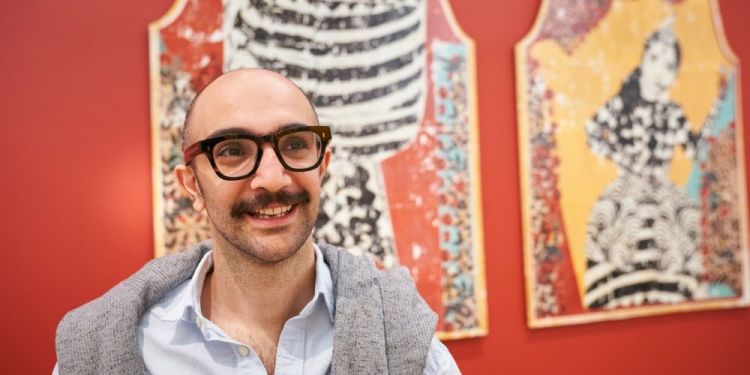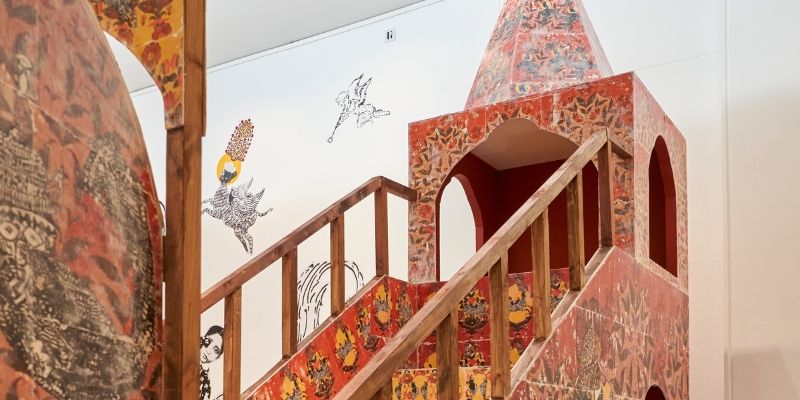Exhibition explores migration, memory and disability

An exhibition by Leeds-based Iranian artist Mohammad Barrangi opens on 1 May at the University of Leeds, as part of the year-long Smeaton300 celebrations.
The new body of work, ‘One Night, One Dream, Life in the Lighthouse’, draws on sources Mohammad Barrangi discovered during a residency in the University’s Special Collections, including calligraphy, textiles, manuscripts and illustrations.
Using sound for the first time in this exhibition, Barrangi weaves together memories, biblical narratives, Persian mythology and European literature to articulate his personal experiences of migration and disability.
We are so excited to be able to bring to our University and the wider city of Leeds the beautiful and inspiring work of this incredibly talented artist.
With a lighthouse motif at its centre, the exhibition reflects on the work of John Smeaton, the UK’s first civil engineer, who was born and died in Leeds. Thanks to a collaboration between the Cultural Institute and the School of Civil Engineering, the University is a partner of the Smeaton300 programme by Foxglove, which celebrates the tricentenary of his birth with this and further events and commissions across the city during 2024.
“My work often focuses on journeys and travelling”, Barrangi said. He is hopeful that the Smeaton commission will encourage viewers to think about the human stories behind the headlines. “With the government’s ‘Rwanda Plan’ and the Channel crossings in the news, it’s a very good time to talk about these things,” Barrangi added.
Dr Laura Claveria, Exhibitions Curator at the University of Leeds, said: “We are so excited to be able to bring to our University and the wider city of Leeds the beautiful and inspiring work of this incredibly talented artist. Centred on his own experiences of travel, migration and disability, Mohammad Barrangi’s latest work engages with the legacy of John Smeaton in ways that feel extremely relevant to our society today. It suggests notions of freedom, memory, community, and cultural identity and calls for worldwide, cross-cultural understanding.”
Distinctive techniques

Image caption: Mohammad Barrangi’s installation The sea is stormy, Lily, part of his exhibition ‘One Night, One Dream, Life in the Lighthouse’.
Barrangi, who was born without the use of his left arm, uses a distinctive technique to create his artwork. Traditional methods like drawing and calligraphy are combined with digital manipulation and 3D printing to create images. Then, he uses his feet to transfer the artwork to objects in layers of colours and textures.
Female characters inspired by empowered women from history – and his own friends and family – are a recurring element, as are figures with missing limbs or hands.
In the centre of the space, made specifically for the exhibition, is a large structure based on a minbar, a pulpit for delivering sermons in mosques. Completely adorned with Barrangi’s designs, the door at its entrance “seems to lead to another world”, and its dome recalls the top of a lighthouse. It is accompanied by a sculpture of a ‘unicorn-zebra’, its stripes formed by outsized strokes from a traditional reed pen.
Elsewhere, works incorporate forms discovered by the artist in the University’s Special Collections, ranging from Chinese and Turkish textiles and Arabic manuscripts to early navigational devices and a book on the paintings of Hieronymus Bosch
The lighthouse and Smeaton300
The exhibition is part of the Leeds-wide Smeaton300 programme, commemorating the 300th anniversary of John Smeaton, who was born in Leeds in 1724. Smeaton is particularly famous for designing the revolutionary Eddystone Lighthouse. Inspired by the shape of an oak tree, its broad base and tapering tower enabled it to withstand the fearsome power of the waves off the coast of Plymouth.
The lighthouse was our starting point for Smeaton300 and brings with it many contrasting emotions: symbolising a place of danger and fear but also standing as beacon of safety and hope.
Conceived by Foxglove, Smeaton300 is a creative programme that brings together artists, scientists, engineers and designers to celebrate his work and to extend his legacy of collaboration and innovation for the public good.
Foxglove’s Abby Dix-Mason and Jane Earnshaw said: “We are delighted that Mohammed Barrangi is responding to the Smeaton300 themes of home and navigation. The lighthouse was our starting point for Smeaton300 and brings with it many contrasting emotions: symbolising a place of danger and fear but also standing as beacon of safety and hope. Mohammed's exhibition at the Stanley & Audrey Burton Gallery will be an opportunity to experience the complexity of these ideas from a deeply creative and personal perspective.”
In collaboration with The Highrise Project and as part of the Galleries’ ongoing Welcoming Migrants initiative, the exhibition will also feature a collective digital artwork made by a group of refugees, asylum seekers and migrants inspired by Barrangi’s exhibition.
Over the course of six workshops, the group has explored the magic of storytelling through collage, print and stop motion animation.
The University Library and Galleries’ engagement with displaced people celebrated another milestone with the recent announcement of an Academic Asylum Seekers and Refugee Access membership, granting free, year-long, reference access to the libraries.
The major new exhibition, ‘One Night, One Dream, Life in the Lighthouse’ runs at The Stanley & Audrey Burton Gallery, University of Leeds from 1 May – 20 July 2024.
Further information
Top image: Mohammad Barrangi with his mixed-media diptych, A girl dancing on her hands and another offering apples, at the opening of his exhibition, ‘One Night, One Dream, Life in the Lighthouse’ at The Stanley & Audrey Burton Gallery, University of Leeds on Tuesday 30 April 2024.
Photo credits: Justin Slee/University of Leeds
For media enquiries, please contact Media and Communications Officer Rowland Thomas on R.Thomas6@leeds.ac.uk.




